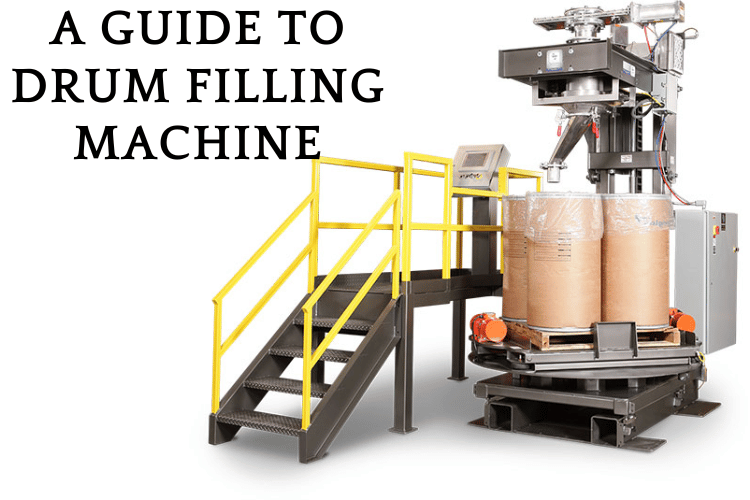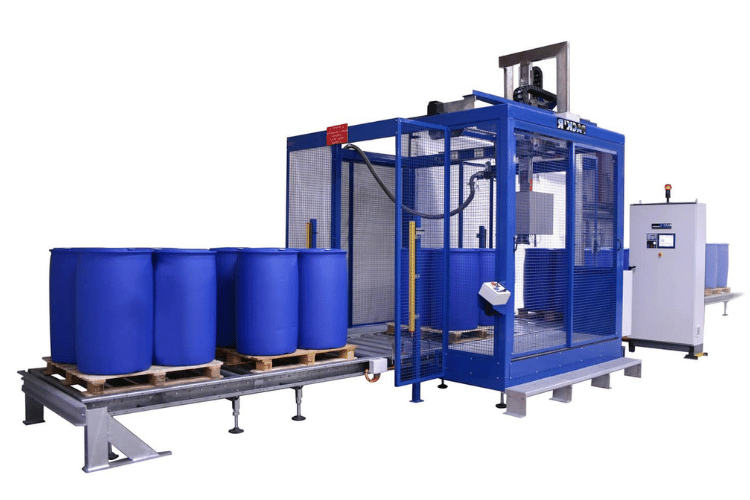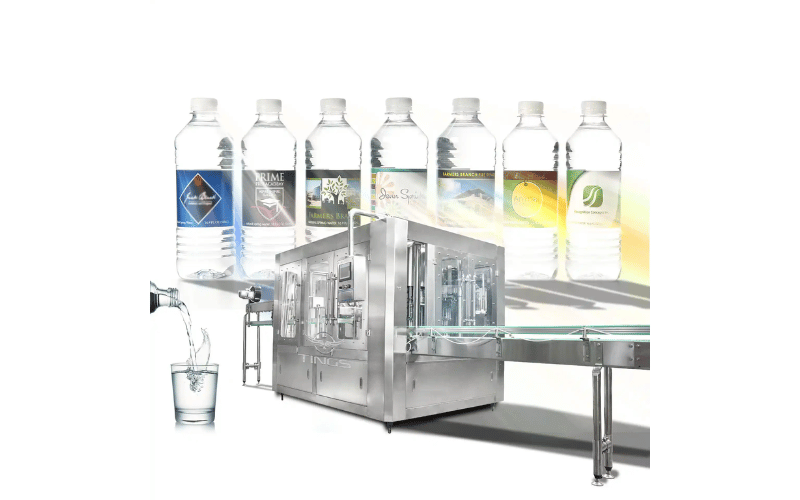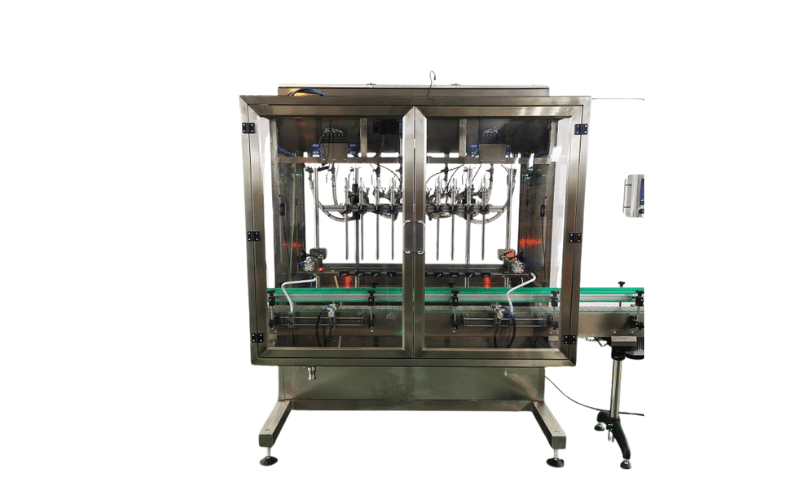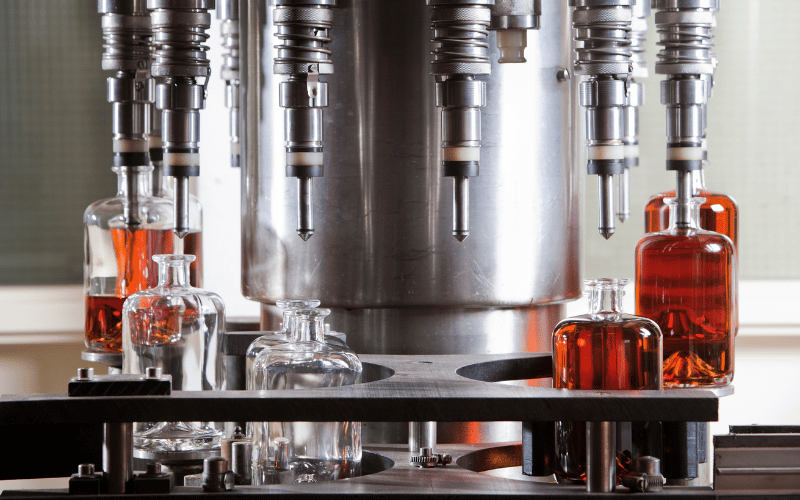Drum filling machines are essential for industries requiring efficient and precise bulk liquid packaging. From chemicals to food and pharmaceuticals, these machines streamline operations with advanced features like automation, subsurface filling, and safety mechanisms. This guide explores the types, applications, and innovations in drum filling technology.
Table of Contents
ToggleIntroduction to Drum Filling Machines
What is a Drum Filling Machine?
A drum filling machine is a specialized piece of equipment designed to accurately and efficiently fill large containers, such as drums, barrels, or Intermediate Bulk Containers (IBCs), with liquid products. These machines are commonly used in industries that handle high volumes of liquids, including chemicals, food and beverage, pharmaceuticals, and petroleum. Unlike smaller bottle fillers, drum filling machines are built to handle larger capacities, often ranging from 5 gallons to over 55 gallons per container.
Drum filling machines are engineered to ensure precision and minimize waste, even when dealing with high-viscosity liquids or hazardous substances. They are equipped with advanced features such as automated weight controls, adjustable nozzles, and safety mechanisms to prevent spills and overflows. Depending on the application, these machines can handle a wide variety of liquids, from water and oils to corrosive chemicals and flammable materials. Their robust construction and ability to handle large-scale operations make them an essential tool for industries requiring bulk liquid packaging.
Types of Drum Fillers
Drum filling machines come in various types, each designed to meet specific operational needs and product characteristics. The choice of drum filler depends on factors such as the type of liquid, the level of automation required, and the production environment. Below are the most common types of drum fillers:
- Top-Fill Drum Fillers:
Top-fill machines dispense liquid into the drum from above, making them ideal for non-foaming liquids or products that do not require precise filling at the surface level. These fillers are often used for high-viscosity liquids like oils, syrups, and adhesives. They are simple to operate and can handle a wide range of drum sizes. - Subsurface Drum Fillers:
Subsurface fillers, also known as bottom-up fillers, are designed to fill drums from the bottom up. This method minimizes foaming and splashing, making it suitable for foamy or volatile liquids such as detergents, chemicals, and carbonated products. The nozzle is inserted into the drum and gradually rises as the liquid fills, ensuring a smooth and controlled process. - Semi-Automatic Drum Fillers:
Semi-automatic drum fillers require some manual intervention, such as positioning the drum and starting the filling process. These machines are cost-effective and offer a balance between automation and operator control, making them suitable for small to medium production volumes. - Fully Automatic Drum Fillers:
Fully automatic drum fillers are designed for high-speed, large-scale operations. These machines can handle multiple drums simultaneously, with features like automated drum positioning, filling, and capping. They are equipped with advanced control systems to ensure precision and efficiency, reducing the need for manual labor. - Explosion-Proof Drum Fillers:
For industries handling flammable or hazardous liquids, explosion-proof drum fillers are essential. These machines are built with specialized materials and safety features to prevent sparks and ensure safe operation in volatile environments.
Each type of drum filler offers unique advantages, and selecting the right one depends on the specific requirements of the production process and the characteristics of the liquid being filled.
Applications of Liquid Filling Equipment
Drum filling machines are versatile and find applications across a wide range of industries that require bulk liquid packaging. Their ability to handle various liquid types and container sizes makes them indispensable for many operations. Below are some of the key applications of drum filling equipment:
- Chemical Industry:
Drum fillers are widely used in the chemical sector to package products such as solvents, acids, detergents, and industrial oils. The precision and safety features of these machines are critical for handling hazardous or corrosive substances, ensuring both efficiency and operator safety. - Food and Beverage:
In the food and beverage industry, drum fillers are used to package bulk quantities of liquids like syrups, sauces, edible oils, and beverages. Subsurface fillers are particularly useful for minimizing foaming in carbonated or aerated products, ensuring consistent quality. - Pharmaceuticals:
The pharmaceutical industry relies on drum filling machines for packaging large volumes of liquid medicines, disinfectants, and other medical-grade solutions. Aseptic or sanitary drum fillers are often used to maintain hygiene and prevent contamination during the filling process. - Petroleum and Lubricants:
Drum fillers are essential for packaging petroleum products, including motor oils, lubricants, and fuel additives. These machines are designed to handle high-viscosity liquids and ensure accurate filling to meet industry standards. - Agriculture:
In the agricultural sector, drum filling equipment is used to package fertilizers, pesticides, and other liquid agrochemicals. Explosion-proof fillers are often required for handling flammable or volatile substances safely. - Paints and Coatings:
Drum fillers are also used in the production of paints, varnishes, and coatings. These machines can handle thick, viscous liquids and ensure precise filling to avoid waste and maintain product consistency.
By catering to such diverse applications, drum filling machines play a vital role in streamlining bulk liquid packaging processes across industries. Their adaptability, precision, and efficiency make them a valuable investment for businesses looking to optimize their operations.
Components of a Drum Filling System
Bungs and Their Importance
Bungs are a critical component of a drum filling system, serving as the primary closure mechanism for drums and barrels. These small yet essential parts are designed to seal the opening of the drum securely, preventing leaks, contamination, and evaporation of the liquid inside. Bungs are typically made from durable materials such as plastic, metal, or rubber, depending on the type of liquid being stored and the environmental conditions the drum will face.
The importance of bungs lies in their ability to maintain the integrity of the product during storage and transportation. For instance, in industries handling hazardous chemicals or volatile substances, bungs with tamper-evident seals or venting capabilities are often used to ensure safety and compliance with regulatory standards. Venting bungs are particularly useful for liquids that release gases, as they allow pressure to escape without compromising the seal.
Bungs are available in various sizes and thread types to match the specific design of the drum. Common configurations include 2-inch and 3/4-inch openings, which are standard for most industrial drums. Proper selection and installation of bungs are essential to ensure a tight seal and prevent operational issues, such as spills or product loss. By understanding the role of bungs in a drum filling system, manufacturers can enhance the safety and efficiency of their liquid packaging processes.
Overview of Filling Equipment
Filling equipment is the backbone of any drum filling system, designed to handle the precise and efficient transfer of liquids into large containers. These machines are equipped with advanced features to ensure accuracy, minimize waste, and maintain product quality. The core components of filling equipment include filling nozzles, control systems, and safety mechanisms, all of which work together to streamline the filling process.
Filling nozzles are responsible for dispensing the liquid into the drum. They are designed to handle various liquid viscosities and flow rates, ensuring consistent and accurate filling. Some nozzles are equipped with anti-drip mechanisms to prevent spills, while others are designed for subsurface filling to minimize foaming or splashing.
Control systems play a crucial role in automating the filling process. Modern equipment is often integrated with programmable logic controllers (PLCs) and sensors that monitor fill levels, detect drum positioning, and adjust flow rates in real time. These systems enhance precision and reduce the need for manual intervention, making them ideal for high-volume operations.
Safety mechanisms are essential for handling hazardous or volatile liquids. Features such as explosion-proof designs, emergency shut-off valves, and pressure relief systems ensure safe operation and compliance with industry standards. Additionally, many machines include built-in cleaning systems to maintain hygiene and prevent cross-contamination between product batches.
By combining these components, filling equipment provides a reliable and efficient solution for packaging liquids in drums, catering to a wide range of industries and applications.
Understanding Liquid Filling Equipment
Liquid filling equipment is a versatile category of machinery designed to handle the packaging of liquids across various industries. These machines are engineered to accommodate different container sizes, liquid viscosities, and production requirements, making them a vital part of modern manufacturing processes. Understanding the key features and capabilities of liquid filling equipment can help businesses select the right solution for their needs.
One of the primary considerations when choosing liquid filling equipment is the type of liquid being handled. Thin, free-flowing liquids like water or solvents are best suited for gravity fillers, which rely on the natural force of gravity to dispense the liquid. For thicker or more viscous products, such as syrups, oils, or creams, piston fillers or pump fillers are more effective, as they use mechanical force to push the liquid into the container.
Another important factor is the level of automation. Semi-automatic machines require some manual input, such as positioning the drum or starting the filling process, making them suitable for small to medium production volumes. Fully automatic systems, on the other hand, are designed for high-speed operations, with features like automated drum handling, filling, and capping. These systems are ideal for large-scale production lines where efficiency and consistency are critical.
Liquid filling equipment also varies in terms of its compatibility with different container types. While some machines are designed specifically for drums and barrels, others can handle a variety of containers, including bottles, pouches, and IBCs. This flexibility is particularly useful for businesses that produce multiple product lines or cater to diverse markets.
By understanding the capabilities and features of liquid filling equipment, manufacturers can optimize their packaging processes, improve product quality, and meet the demands of their industry. Whether handling food-grade liquids, hazardous chemicals, or pharmaceutical solutions, the right equipment ensures efficiency, safety, and reliability.
Types of Liquid Filling Solutions
Single Drum Fillers
Single drum fillers are specialized machines designed to fill individual drums with liquid products efficiently and accurately. These systems are ideal for operations that require precise filling of large containers, such as 55-gallon drums, and are commonly used in industries like chemicals, food processing, and pharmaceuticals. Single drum fillers are particularly suited for applications where high accuracy and minimal waste are critical.
These machines typically feature a single filling station, where the drum is manually or automatically positioned under the filling nozzle. The nozzle is designed to handle a variety of liquid viscosities, from thin, free-flowing liquids to thick, viscous substances. Many single drum fillers are equipped with subsurface filling capabilities, which allow the nozzle to fill the drum from the bottom up. This method minimizes foaming and splashing, making it ideal for foamy or volatile liquids.
Single drum fillers often include advanced features such as weight-based filling systems, which ensure that each drum is filled to the exact specified volume. Additionally, these machines may have safety mechanisms like anti-drip nozzles and emergency shut-off valves to prevent spills and ensure safe operation. While single drum fillers are typically used for lower production volumes, their precision and reliability make them an essential solution for businesses handling high-value or sensitive liquids.
Tote Fillers and Their Uses
Tote fillers are designed to fill large Intermediate Bulk Containers (IBCs), commonly referred to as totes, with liquid products. These systems are ideal for industries that require bulk packaging solutions, such as agriculture, petroleum, and industrial chemicals. Totes are often used for transporting and storing large quantities of liquids, typically ranging from 275 to 330 gallons, making tote fillers a critical component of high-volume operations.
Tote filling systems are engineered to handle a wide range of liquid types, including hazardous chemicals, food-grade products, and viscous materials. They are equipped with adjustable nozzles and filling arms to accommodate different tote sizes and designs. Many tote fillers also feature weight-based or volumetric filling systems to ensure precise and consistent fills, reducing waste and improving efficiency.
One of the key advantages of tote fillers is their ability to handle both top-fill and bottom-fill operations. Top-fill systems are suitable for non-foaming liquids, while bottom-fill systems are designed to minimize foaming and splashing, making them ideal for volatile or aerated products. Additionally, tote fillers often include safety features such as explosion-proof designs, spill containment systems, and automated shut-off mechanisms to ensure safe handling of hazardous materials.
Tote fillers are available in both semi-automatic and fully automatic configurations. Semi-automatic systems require some manual intervention, such as positioning the tote and starting the filling process, while fully automatic systems handle these tasks independently, making them suitable for large-scale production lines. By providing a reliable and efficient solution for bulk liquid packaging, tote fillers play a vital role in streamlining operations and meeting the demands of various industries.
Pail Filling Systems
Pail filling systems are designed to fill smaller containers, typically ranging from 1 to 5 gallons, with liquid products. These systems are widely used in industries such as paints and coatings, food and beverage, and personal care, where smaller packaging sizes are required for retail or commercial distribution. Pail filling systems offer a versatile and efficient solution for handling a variety of liquid types and container designs.
These systems are equipped with filling nozzles that can handle different viscosities, from thin liquids like water and solvents to thicker substances like adhesives and creams. Many pail fillers include adjustable settings to accommodate various pail sizes and shapes, ensuring flexibility for diverse product lines. Additionally, pail filling systems often feature anti-drip mechanisms and precise volume controls to minimize waste and maintain product consistency.
Pail filling systems are available in manual, semi-automatic, and fully automatic configurations. Manual systems are suitable for small-scale operations, where operators manually position the pail and control the filling process. Semi-automatic systems automate some aspects, such as nozzle positioning or fill level detection, while fully automatic systems handle the entire process, including pail handling, filling, and sealing.
One of the key benefits of pail filling systems is their compact design, which makes them suitable for facilities with limited space. They are also easy to clean and maintain, ensuring compliance with hygiene standards in industries like food and pharmaceuticals. By offering a reliable and adaptable solution for small-scale liquid packaging, pail filling systems help businesses improve efficiency and meet the needs of their customers.
Automation in Drum Filling
Benefits of Fully Automatic Drum Filling
Fully automatic drum filling systems are a game-changer for industries that require high-volume liquid packaging. These systems are designed to handle the entire filling process with minimal human intervention, offering unparalleled efficiency, precision, and consistency. One of the most significant benefits of fully automatic drum fillers is their ability to significantly increase production speed. By automating tasks such as drum positioning, filling, and capping, these systems can process hundreds of drums per hour, making them ideal for large-scale operations.
Another advantage is the precision offered by fully automated systems. Advanced technologies, such as weight-based filling and programmable logic controllers (PLCs), ensure that each drum is filled to the exact specified volume, reducing waste and improving product consistency. This level of accuracy is particularly important for industries like chemicals and pharmaceuticals, where precise measurements are critical.
Fully automatic drum fillers also enhance workplace safety by minimizing the need for manual handling of heavy drums and hazardous liquids. Features such as spill containment systems, explosion-proof designs, and automated shut-off mechanisms ensure safe operation, even in challenging environments. Additionally, these systems are often equipped with real-time monitoring and diagnostic tools, allowing operators to identify and address issues quickly, further reducing downtime and maintenance costs.
Semi-Automatic vs. Fully Automatic Systems
When choosing between semi-automatic and fully automatic drum filling systems, it’s essential to consider the specific needs of your operation. Both types of systems offer unique advantages, and the right choice depends on factors such as production volume, budget, and the level of automation required.
Semi-Automatic Systems:
Semi-automatic drum fillers require some manual intervention, such as positioning the drum under the filling nozzle or starting the filling process. These systems are more affordable than fully automatic options and are ideal for small to medium production volumes. They offer a balance between automation and operator control, making them suitable for businesses that need flexibility or handle a variety of drum sizes and liquid types. However, semi-automatic systems may require more labor and are slower than their fully automated counterparts.
Fully Automatic Systems:
Fully automatic drum fillers handle the entire process, from drum handling to filling and sealing, without the need for manual input. These systems are designed for high-speed, large-scale operations and offer superior efficiency and precision. While the initial investment in fully automatic systems is higher, the long-term benefits in terms of reduced labor costs, increased productivity, and improved accuracy often outweigh the upfront expense. Fully automatic systems are best suited for industries with consistent, high-volume production needs.
By weighing the pros and cons of each system, manufacturers can select the solution that aligns with their operational goals and budget.
Features of Automatic Drum Filling Machines
Automatic drum filling machines are equipped with a range of advanced features that enhance their performance, reliability, and ease of use. These features are designed to streamline the filling process, improve accuracy, and ensure safe operation. Below are some of the key features commonly found in automatic drum fillers:
- Weight-Based Filling:
Many automatic drum fillers use weight-based systems to ensure precise filling. These systems measure the weight of the liquid as it is dispensed, automatically stopping the flow once the desired weight is reached. This eliminates the risk of overfilling or underfilling, reducing waste and ensuring product consistency. - Subsurface Filling:
Subsurface filling capabilities allow the nozzle to fill the drum from the bottom up, minimizing foaming and splashing. This feature is particularly useful for foamy or volatile liquids, such as detergents, chemicals, and carbonated products. - Automated Drum Handling:
Fully automatic systems include mechanisms for positioning, moving, and sealing drums without manual intervention. This not only speeds up the process but also reduces the risk of operator injury, especially when handling heavy drums. - Explosion-Proof Designs:
For industries dealing with flammable or hazardous liquids, explosion-proof drum fillers are essential. These machines are built with specialized materials and safety features to prevent sparks and ensure safe operation in volatile environments. - Real-Time Monitoring and Diagnostics:
Advanced control systems with real-time monitoring capabilities allow operators to track the performance of the machine and identify potential issues before they escalate. Diagnostic tools provide detailed insights into system health, enabling proactive maintenance and minimizing downtime. - Customizable Settings:
Automatic drum fillers often include programmable settings that allow operators to adjust parameters such as fill volume, flow rate, and nozzle height. This flexibility makes it easy to accommodate different drum sizes, liquid viscosities, and production requirements. - Integrated Spill Containment:
Many systems are equipped with spill containment features to capture any accidental leaks or overflows, ensuring a clean and safe working environment. This is especially important for industries handling hazardous or corrosive liquids.
By incorporating these features, automatic drum filling machines provide a reliable and efficient solution for bulk liquid packaging. Their advanced capabilities not only improve productivity but also enhance safety and product quality, making them a valuable investment for modern manufacturing operations.
Considerations for Choosing a Drum Filler
Container Sizes and Compatibility
One of the most important factors to consider when selecting a drum filler is the range of container sizes it can accommodate. Drum fillers are designed to handle a variety of container types, including standard 55-gallon drums, smaller pails, and larger Intermediate Bulk Containers (IBCs). Ensuring that the machine is compatible with the specific sizes and shapes of your containers is critical for seamless operation and efficiency.
For businesses that handle multiple container sizes, it’s essential to choose a drum filler with adjustable settings or interchangeable components. Features like adjustable filling nozzles, height settings, and conveyor systems allow the machine to adapt to different container dimensions without requiring extensive modifications. This flexibility is particularly valuable for manufacturers with diverse product lines or those catering to various market demands.
Additionally, the material and design of the containers should be considered. For example, plastic drums may require different handling mechanisms compared to metal barrels, and containers with narrow openings may need specialized nozzles for precise filling. By selecting a drum filler that aligns with your container specifications, you can optimize productivity and reduce the risk of operational issues.
Liquid Type and Viscosity
The type and viscosity of the liquid being filled play a significant role in determining the most suitable drum filler for your operation. Different liquids have unique flow characteristics, and the filling machine must be capable of handling these variations to ensure accuracy and efficiency.
For thin, free-flowing liquids like water, solvents, or cleaning solutions, gravity-based or pump fillers are often sufficient. These systems rely on the natural flow of the liquid or mechanical pumps to transfer the product into the container. On the other hand, thicker or more viscous liquids, such as syrups, oils, or adhesives, require specialized equipment like piston fillers or high-pressure pump systems. These machines are designed to handle the resistance of dense liquids, ensuring consistent and precise filling.
Foamy or volatile liquids, such as detergents or carbonated products, may require subsurface filling capabilities. This method involves inserting the nozzle into the container and filling from the bottom up, which minimizes foaming and splashing. Additionally, for hazardous or flammable liquids, explosion-proof drum fillers with safety features like sealed systems and anti-static components are essential to ensure safe operation.
By understanding the properties of the liquid being filled, manufacturers can select a drum filler that meets their specific requirements, ensuring both efficiency and product quality.
Food Grade and Safety Standards
For industries like food and beverage, pharmaceuticals, and cosmetics, compliance with food-grade and safety standards is a critical consideration when choosing a drum filler. These industries require equipment that meets strict hygiene and regulatory requirements to ensure the safety and quality of the products being packaged.
Food-grade drum fillers are constructed from materials that are safe for contact with consumable products, such as stainless steel. These materials are resistant to corrosion, easy to clean, and do not react with the liquid being filled. Additionally, food-grade fillers often include features like sanitary nozzles, smooth surfaces, and CIP (Clean-In-Place) systems, which allow for thorough cleaning without disassembling the equipment.
Compliance with safety standards, such as FDA (Food and Drug Administration) regulations or EU food safety directives, is also essential. Manufacturers should ensure that the drum filler is certified to meet these standards, as non-compliance can result in product recalls, legal penalties, and damage to brand reputation.
For operations handling allergenic or sensitive products, it’s important to choose a drum filler with features that prevent cross-contamination. This may include separate filling lines for different products or advanced cleaning systems that eliminate residue between production runs. By prioritizing food-grade and safety standards, businesses can protect consumer health, maintain regulatory compliance, and build trust in their brand.
Conclusion: The Future of Drum Filling Technology
Innovations in Filling Systems
The drum filling industry is undergoing significant advancements, driven by the need for greater efficiency, precision, and sustainability. One of the most notable innovations is the integration of smart technologies, such as IoT (Internet of Things) and AI (Artificial Intelligence), into filling systems. These technologies enable real-time monitoring, predictive maintenance, and data-driven decision-making, allowing manufacturers to optimize their operations and reduce downtime. For example, IoT-enabled sensors can track fill levels, detect anomalies, and send alerts to operators, ensuring consistent performance and minimizing waste.
Another key innovation is the development of modular filling systems. These systems are designed to be easily reconfigured or expanded, providing manufacturers with the flexibility to adapt to changing production needs. Modular designs also simplify maintenance and reduce the cost of upgrades, making them a cost-effective solution for businesses of all sizes.
Sustainability is also a major focus in the evolution of drum filling technology. Manufacturers are increasingly adopting energy-efficient equipment, recyclable materials, and water-saving cleaning systems to reduce their environmental impact. Additionally, advancements in precision filling technology are helping to minimize product waste, further contributing to sustainability goals.
Market Trends in Packaging Machines
The global market for drum filling and packaging machines is experiencing steady growth, fueled by increasing demand across industries such as chemicals, food and beverage, and pharmaceuticals. One of the key trends shaping the market is the shift toward automation. Fully automated systems are becoming more popular as manufacturers seek to improve efficiency, reduce labor costs, and enhance product quality. This trend is particularly evident in high-volume industries, where the benefits of automation are most pronounced.
Another emerging trend is the growing demand for customized solutions. As consumer preferences evolve, manufacturers are looking for equipment that can handle a wide variety of container sizes, liquid types, and production requirements. This has led to the development of highly versatile filling systems that can be tailored to meet specific operational needs.
The rise of e-commerce and global trade is also driving demand for advanced packaging machines. With more products being shipped internationally, there is a greater need for reliable and efficient filling systems that can handle bulk packaging while ensuring product safety and compliance with international standards.
Final Thoughts on Drum and Tote Fillers
Drum and tote fillers are essential tools for industries that require bulk liquid packaging, offering a combination of efficiency, precision, and versatility. As technology continues to evolve, these machines are becoming more advanced, with features like smart controls, modular designs, and sustainable solutions setting new benchmarks for performance. By staying ahead of market trends and embracing innovations, manufacturers can optimize their operations, meet consumer demands, and remain competitive in an ever-changing landscape.
Frequently Asked Questions
Q: What are the main types of drum filling machines?
A: Drum filling machines are primarily categorized into automatic and semi-automatic systems, designed to fill containers such as 55-gallon drums, totes, and IBCs. These machines can operate using net weight or volumetric filling methods, depending on the application. Additionally, they support top-fill or bottom-fill techniques to handle various liquid products, including lubricants, chemicals, and paints.
Q: What are the benefits of using a palletized drum filling system?
A: A palletized drum filling system boosts efficiency by enabling multiple drums to be filled simultaneously, significantly reducing labor costs and increasing production throughput. These systems are ideal for bulk filling operations and can be seamlessly integrated with conveyor systems to streamline palletizing, packaging, and transportation processes.
Q: How do filling lances improve the filling process?
A: Filling lances are specialized tools that enhance the accuracy and efficiency of the filling process by directing liquid flow into the container. They are available for both top-fill and bottom-fill operations, depending on the liquid type and filling requirements. By minimizing foaming and ensuring consistent fill levels, filling lances contribute to a smoother and more precise filling process.
Q: What is net weight filling, and how does it differ from volumetric filling?
A: Net weight filling measures the exact weight of the liquid being dispensed, ensuring precise quantities are filled into drums or totes. This method is ideal for high-value or sensitive liquids, as it minimizes waste and ensures compliance with strict filling standards. In contrast, volumetric filling measures the liquid’s volume, which may be less accurate for products with varying densities or viscosities.
Q: What types of liquid filling equipment are available for different industries?
A: Liquid filling equipment is designed to meet the needs of various industries, including food-grade machines for the food and beverage sector, and specialized systems for personal care products, chemicals, or agricultural solutions. Options range from fully automatic systems for high-volume production to semi-automatic drum fillers for smaller-scale operations, allowing businesses to select the best configuration for their specific requirements.
Q: How can I ensure my drum filling machine is sanitary?
A: To maintain a sanitary drum filling machine, choose equipment with hygienic features such as smooth, easy-to-clean surfaces and materials that meet health and safety regulations. Regular cleaning and maintenance protocols are essential, especially when handling food-grade or personal care products, to prevent contamination and ensure compliance with industry standards.
Q: What is the role of a PLC control in a filling system?
A: A PLC (Programmable Logic Controller) system automates and optimizes the filling process by providing precise control over machine operations. It allows operators to adjust fill parameters, monitor performance metrics, and integrate the filling system with other packaging equipment. This ensures consistent, efficient, and reliable operation across production lines.
Q: Can I use the same filling equipment for different container types?
A: Yes, many filling machines are designed to accommodate a variety of container types, including drums, totes, and pails. However, it’s important to adjust the machine settings and configurations to match the specific requirements of each container type. This ensures optimal performance, accuracy, and efficiency for diverse packaging needs.
Conclusion
Drum filling machines are revolutionizing bulk liquid packaging with their precision, efficiency, and adaptability. By embracing advanced technologies and tailored solutions, industries can optimize their operations, enhance safety, and meet diverse production needs. The future of drum filling is set to redefine efficiency and sustainability in manufacturing.

